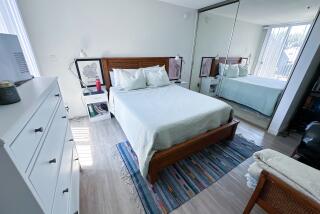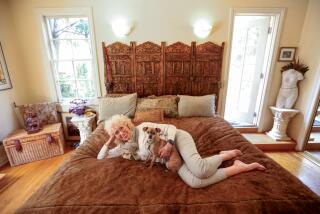Unsightly Recliner Redesigned to Attract Style-Conscious Baby Boomers
- Share via
Recliner salesman Mike Bartee readily rattled off the virtues of his product: comfort, durability and practicality. Beauty, however, was not on the list.
“They’re not sold as a thing of beauty,” said Bartee, a salesman at the La-Z-Boy Showcase Shoppe in Glendale. “They’re built for comfort.”
Three feet wide and upholstered in synthetic fabric or Naugahyde, the traditional recliner has been a dream for couch potatoes and a nightmare for decorators. But the ugly duckling of American furniture is getting a face lift to make it more appealing to aging baby boomers who have acquired a taste for high-priced and high-style products.
With sales stagnant at about $32 billion annually, the home furnishings industry is counting on the senior members of the 70 million Americans born between 1946 and 1964 to boost revenue and profit as they enter their late 30s and early 40s--the peak years for furniture buying.
“They are now in the position of replacing their first furniture they bought 10 years ago,” said furniture analyst Glenn Goodwin of BDO Seidman, an accounting firm. “They will buy a piece here and a piece there that is more high quality and more upscale. That’s not just true for recliners, but it’s true for dining room sets and living room sofas.”
The rise of the stylish recliner is coming as baby boomers are settling down and spending more time at home with their families. About $2 billion worth of “motion furniture,” mostly recliners, is sold annually in the United States.
“Recliners are a necessary vice,” said San Francisco furniture designer Karl Felperin. “Baby boomers are getting older and more likely to be sedentary. They have to have a way to be comfortable.”
While traditional recliners are still the most popular, highly prized young, affluent customers are often turned off by the idea of plopping a big recliner into the middle of a designer living room, many furniture executives say.
“When people think of a recliner, they think of something big, ugly, covered with Herculon fabric and with a large wooden handle on the side,” said Scott Young, vice president of Bradington & Young, a North Carolina maker of upscale recliners. “You don’t have a den any more, where people used to shove these recliners into when guests came over.”
In response, such recliner makers as Barcalounger and La-Z-Boy have added luxury lines that feature expensive leather and fabrics and a mix of styles ranging from contemporary to traditional wingback chair. Designers have reduced the width of chairs by up to a foot to fit smaller homes, but price tags have swollen to nearly $2,000 for some models.
“We try to manufacture a good-looking chair that has the added benefit that it also reclines,” said Philip Edwards, vice president of sales and marketing at Barcalounger. One of the firm’s top sellers this year is a glazed-leather wingback chair with a ball-and-claw leg.
“You would never know it was a recliner,” Edwards said of the $1,100 chair.
Robert Kemeny, president of the 11-store Barker Bros. furniture chain, said “the yuppie customers are more tuned into leathers, luxurious fabrics and not as bulky a look. It used to be that you could spot a Herculon velvet recliner right away.”
There are no Herculon velvet recliners at trendy Rapport International Home Furnishings on La Brea Avenue. Recliners take the form of jet-black leather cubes or sleek combinations of beechwood and Norwegian leather priced at $799.
“There is a way with good design to achieve comfort without it being ugly,” said owner Jerry Rapport. “People want the ability to lounge and recline in a chair . . . but they are sold first on the basis of style.”
For all the new styles, traditionally styled recliners priced below $500 remain the most popular. “If you are going after middle America,” said Edwards at Barcalounger, “you’re manufacturing what looks like the recliner that your father used to have. We also manufacture some of the big clunkers.”
At the La-Z-Boy store in Glendale, the best seller is the 36-inch-wide “Avenger” model. “It’s almost like a bed,” said Martee, who notes that his typical customer is a man about 50 years old.
Martee said that women tend to like wingback recliners and that “the younger folks buy the smaller chairs because they don’t have much space at home.”
The move toward more stylish recliners includes efforts by chair makers to get retailers to better display the more expensive lines. Many would like the chairs integrated into living room settings instead of set off in a corner.
“They often have a line of them like tin soldiers,” said Young at Bradington & Young. “You have to romance the product. You’ve got to get the customer to say: ‘It’s a pretty chair, and, hey, it reclines, too.’ ”
Congress Scrutinizes 30-Minute TV Ads
Those 30-minute commercials that sell everything from diets to car wax fell under the scrutiny of a congressional subcommittee last week.
Since rules regulating commercials were relaxed in the 1980s, 30-minute ads have proliferated on cable and late-night television, when air time is less expensive. The programs generate annual sales of $500 million, a figure expected to triple by 1992, officials say.
But recent fraud charges have tainted the industry’s reputation. In April, Phoenix-based Twin Star Productions paid $1.5 million to settle Federal Trade Commission allegations that three of the company’s commercials were deceptive, including one that featured Michael Reagan, son of the former President.
“We’re looking at consumer fraud in the form of these program-length commercials,” said Steve Jenning, staff director of the House Small Business Committee. “There is a high proportion in the genre that are false and deceptive.”
Industry officials disagree.
“There have been a few that have abused the medium and violated some federal regulations,” said Greg Renker, co-owner of Guthy-Renker Corp., who testified before the committee. “But that can happen in any medium.
“We are being lumped into a category that we don’t belong in,” said Renker, whose Palm Desert-based firm creates commercials for self-help and get-rich cassettes and books. “The consumer thinks we are all up to the same tricks.”
Moving Walls Help to Sell Office Space
How do you sell office space in a 52-story skyscraper? Colin P. Sheppard finds that mirrors, models and moving walls help.
These are what prospective tenants will find at the marketing center for Figueroa at Wilshire, a $200-million tower nearing completion in downtown Los Angeles. The marketing center, built at a cost reportedly exceeding $1 million, is akin to a model home. Such high-priced showrooms will become more common as competition for tenants grows, real estate executives say.
At the center, moving walls--operated by remote controls--reveal mirrored rooms and intricate models that open up mechanically to show the lobby and fountains flowing with water. The grand finale features another moving wall that hides a window and a view of the skyscraper itself.
“It’s like a cheap thrill, but people love to see walls move,” said Sheppard, who works for developer Gerald D. Hines Interests, a pioneer in such tenant-wooing centers.
Besides selling space--the building is 80% preleased--the mechanically powered model has attracted a lot of fans, says Sheppard. “We had one wealthy individual offer to buy it for his train set.”
The copier division of Toshiba America Information Systems has switched ad agencies, dropping NW Ayer in favor of the Los Angeles office of Della Femina, McNamee. Additional spending will triple the size of the account to about $10 million. . . .
Carnation Co. has named two Los Angeles subsidiaries of the Interpublic Group of Companies to handle advertising for its Buitoni and Libby canned meat lines. McCann-Erickson Los Angeles will take over the Buitoni line. Daily & Associates will pick up Libby, as well as Contadina canned tomato products.


